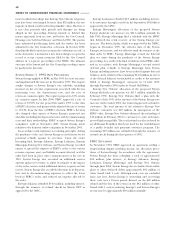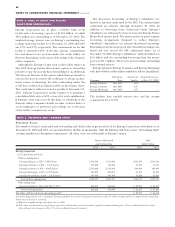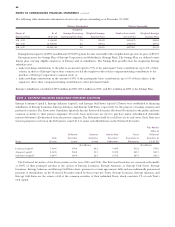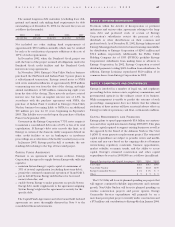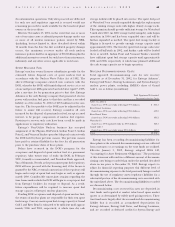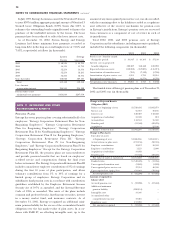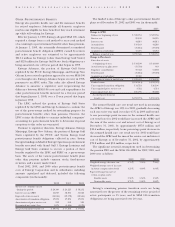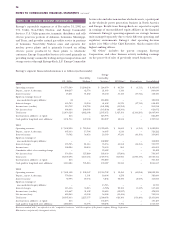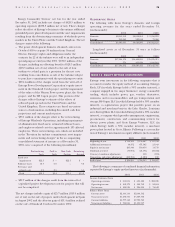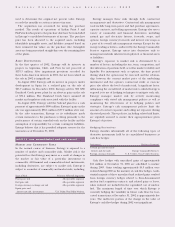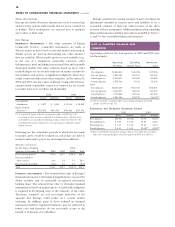Entergy 2002 Annual Report Download - page 71
Download and view the complete annual report
Please find page 71 of the 2002 Entergy annual report below. You can navigate through the pages in the report by either clicking on the pages listed below, or by using the keyword search tool below to find specific information within the annual report.
decontamination operations. Only after proceeds are dedicated
for such use and regulatory approval is secured would any
remaining proceeds be made available for the benefit of plant
owners or their creditors.
Effective November 15, 2001, in the event that one or more
acts of terrorism cause accidental property damage under one
or more of all nuclear insurance policies issued by NEIL
(including, but not limited to, those described above) within
12 months from the date the first accidental property damage
occurs, the maximum recovery under all such nuclear
insurance policies shall be an aggregate of $3.24 billion plus the
additional amounts recovered for such losses from reinsurance,
indemnity, and any other source applicable to such losses.
SPENT NUCLEAR FUEL
Entergy’s nuclear owner/licensee subsidiaries provide for the
estimated future disposal costs of spent nuclear fuel in
accordance with the Nuclear Waste Policy Act of 1982. The
affected Entergy companies entered into contracts with the
DOE, whereby the DOE will furnish disposal service at a cost
of one mill per net kWh generated and sold after April 7, 1983,
plus a one-time fee for generation prior to that date. Entergy
Arkansas is the only Entergy company that generated electric
power with nuclear fuel prior to that date and has a recorded
liability as of December 31, 2002 of $153 million for the one-
time fee. The fees payable to the DOE may be adjusted in the
future to assure full recovery. Entergy considers all costs
incurred for the disposal of spent nuclear fuel, except accrued
interest, to be proper components of nuclear fuel expense.
Provisions to recover such costs have been or will be made in
applications to regulatory authorities.
Entergy’s Non-Utility Nuclear business has accepted
assignment of the Pilgrim, FitzPatrick, Indian Point 3, Indian
Point 2, and Vermont Yankee spent fuel disposal contracts with
the DOE held by their previous owners. The previous owners
have paid or retained liability for the fees for all generation
prior to the purchase dates of those plants.
Delays have occurred in the DOE’s program for the
acceptance and disposal of spent nuclear fuel at a permanent
repository. After twenty years of study, the DOE, in February
2002, formally recommended, and President Bush approved,
Yucca Mountain, Nevada as the permanent spent fuel repository.
DOE will now proceed with the licensing and, if the license is
granted by the NRC, eventual construction of the repository will
begin and receipt of spent fuel may begin as early as approxi-
mately 2010. Considerable uncertainty remains regarding the
time frame under which the DOE will begin to accept spent fuel
from Entergy’s facilities for storage or disposal. As a result,
future expenditures will be required to increase spent fuel
storage capacity at Entergy’s nuclear plant sites.
Pending DOE acceptance and disposal of spent nuclear fuel,
the owners of nuclear plants are responsible for their own spent
fuel storage. Current on-site spent fuel storage capacity at Grand
Gulf 1 and River Bend is estimated to be sufficient until approx-
imately 2006 and 2004, respectively, at which time dry cask
storage facilities will be placed into service. The spent fuel pool
at Waterford 3 was recently expanded through the replacement
of the existing storage racks with higher density storage racks.
This expansion should provide sufficient storage for Waterford
3 until after 2010. An ANO storage facility using dry casks began
operation in 1996 and has been expanded since and will be
further expanded as needed. The spent fuel storage facility at
Pilgrim is licensed to provide enough storage capacity until
approximately 2012. The first dry spent fuel storage casks were
loaded at FitzPatrick in 2002, and further casks will be loaded
there as needed. Indian Point and Vermont Yankee currently
have sufficient spent fuel storage capacity until approximately
2004 and 2006, respectively, at which time planned additional
dry cask storage capacity are to begin operation.
NUCLEAR DECOMMISSIONING COSTS
Total approved decommissioning costs for rate recovery
purposes as of December 31, 2002, for Entergy Arkansas’,
Entergy Gulf States’, Entergy Louisiana’s, and System Energy’s
nuclear power plants, excluding SMEPA’s share of Grand
Gulf 1, are as follows (in millions):
Total Approved Estimated
Decommissioning Costs
ANO 1 & ANO 2
(based on a 1998 cost study reflecting 1997 dollars) $ 813.1
River Bend- Louisiana
(based on a 1996 cost study reflecting 1996 dollars) 419.0
River Bend- Texas
(based on a 1996 cost study reflecting 1996 dollars) 385.2
Waterford 3
(based on a 1994 updated study in 1993 dollars) 320.1
Grand Gulf 1
(based on a 1994 cost study using 1993 dollars) 341.1
Total $2,278.5
Entergy has been recording decommissioning liabilities for
these plants as the estimated decommissioning costs are collected
from customers or as earnings on the trust funds are realized.
Effective January 1, 2003, Entergy adopted SFAS 143,
“Accounting for Asset Retirement Obligations.” The provisions
of this statement will result in a different amount of decommis-
sioning costs being recorded than under the method described
above in use prior to December 31, 2002. Entergy expects to
adjust for financial reporting purposes this different level of
decommissioning expense to the level previously being recorded
through the use of regulatory assets/regulatory liabilities for a
substantial portion of the decommissioning costs associated with
the units listed above. The decommissioning liabilities recorded
are discussed below.
Decommissioning costs recovered in rates are deposited in
trust funds and reported at market value based upon market
quotes or as determined by widely used pricing services. These
trust fund assets largely offset the accumulated decommissioning
liability that is recorded as accumulated depreciation for
Entergy Arkansas, Entergy Gulf States, and Entergy Louisiana,
and are recorded as deferred credits for System Energy and
ENTERGY CORPORATION AND SUBSIDIARIES 2002 69



